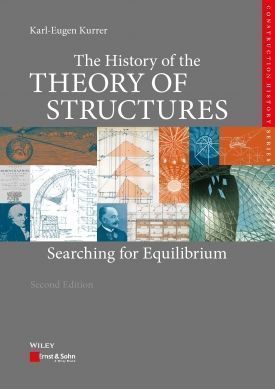The second German edition of Karl-Eugen Kurrer’s Geschichte der Baustatik [history of the theory of structures, ed.] was published at the start of 2016. Compared with the first German edition published in 2002, the number of pages has doubled, and compared with the English edition of 2008, the number of pages has increased by almost 50 %. Okay, so that’s the difference in terms of quantity, but what else is different in this new edition?
The first thing the reader notices is the attempt to look more closely at more recent events in theory of structures. The revolution caused by numerical simulation, especially the use of the finite element method, is becoming increasingly significant. Karl-Eugen Kurrer summarizes the essential points under the heading of “computational mechanics”. And the crux here is that this common methodology blurs the boundaries between the various construction engineering disciplines more and more. As ever with Dr. Kurrer, the roles played by the people who gave momentum to this progress are central to the story. For example, a key figure in this development is J. H. Argyris, whose statement “The computer shapes the theory” (1965) was a powerful signal in this movement. At the same time, however, Dr. Kurrer traces the origins of the evolution of “machine-based computation” as the new “intellectual technology”: Konrad Zuse, the algebra of tensors and matrices, the growth in the “operative use of symbols” from the 19th to the 20th century. After all, Karl-Eugen Kurrer sees in this the drift towards a “universal technology” in the formation of engineering science theories, the basis for which can be found in the conservation laws of mechanics and the methods derived from those.
The second big change compared with the English edition is the inclusion of the history of geotechnics, which in the form of foundation engineering and soil mechanics was previously a subdiscipline of theory of structures. In recent decades in particular, geotechnics has increasingly become a special field that Dr. Kurrer reassesses as a key issue in the history of construction engineering. Splitting up the art of building into technical and artistic parts in the 18th and 19th centuries was not the reason behind the development of the architectural and construction engineering professions. Instead, the construction of foundations and fortifications are the problem areas that led to the formation of theories and also gave the profession its identity. It is not beam statics, but earth pressure theory that counts as the reference point in theory of structures. This not insignificant reappraisal of the historical development is confirmed in the new fifth chapter to the book (more than 100 pages) through a detailed reworking of the history of foundation engineering and soil mechanics. This chapter alone has the quality of a monograph.
The message that this new chapter gives us is crucial for the overall context of this second, revised edition of Geschichte der Baustatik. To a certain extent it justifies the view of Karl-Eugen Kurrer that “breaking the dominance of the linear” reflects a general tendency in the formation of technical theories which is only possible with the help of computers. However, the status of the classical theories is not diminished by this because they remain channels to knowledge.
Around 1917 the Austrian engineer Karl von Terzaghi realized that attempting to formulate universal relationships for soil-structure interaction was hopeless (347), something Otto Mohr had already recognized (372). Material laws such as Hooke’s law, which is sufficient for conventional building materials, are not available for soils. In addition to the physical non-linearity of a soil continuum, there is its geometrical non-linearity as well (365). Terzaghi introduced a new way of forming a theory. It was not the “theory of earth pressure” that had to undergo further development at the start of the 20th century. What were needed were new insights into the physical behaviour of the soil (347). Dr. Kurrer links Terzaghi’s switch to specific research into isolated physical phenomena (in conjunction with comprehensive experimentation) with the realization that the “style of theory” totally changed in this period.
Similar developments can be seen in other areas of construction engineering. For example, during the 1930s all structural engineers were talking about the plastic hinge method – but had to struggle with the logical inconsistencies (the paradox of the plastic hinge method). The dispute between Stüssi and Thürlimann at ETH Zurich continued into the 1960s and demonstrates the changeover from understanding loadbearing structures on the basis of elastic theory to understanding them based on plastic theory. Stüssi saw, wrongly, the latter as inappropriate, a simplification, indeed, as a “theory of structures for idiots” (136). When it comes to these two disciplines, the developments of the 1930s can be described, if not as a scientific revolution, then at least as a paradigm change. In the following years, other disciplines, e.g. aircraft design, fostered the transition to computer-assisted structural mechanics just as much.
Karl-Eugen Kurrer’s fundamental approach to the history of the theory of structures has remained the same in this edition despite the extraordinary amount of additional material compared with the previous editions. Characteristic to his tactic is the way he always tries to bear in mind the people involved and the historical circumstances surrounding developments. To maintain order he continues to divide the evolution of this discipline into periods according to a concept devised in the 1980s by H. Laitko and M. Guntau. Dr. Kurrer begins with the Renaissance and distinguishes between the following overlapping phases of the preparatory period (1575–1825): the orientation (1575–1700), application (1700–1775) and initial (1775–1825) phases in the creation of this discipline and the discipline-formation period (1825–1900) itself as the first legs on the journey towards the discipline of “theory of structures”. This latter period is broken down into the constitution (1825–1850), establishment (1850–1875) and classical (1875–1900) phases, which are followed by the consolidation period (1900–1950), divided into the accumulation (1900–1925) and invention (1925–1950) phases, and finally the integration period (1950 to the present day), which includes the innovation (1950–1975) and diffusion phases (1975 to date) for the knowledge involved in this discipline. This subdivision approach is, however, also applied to the development of other technical disciplines and subdisciplines, such as geotechnics. But this is not without its problems as, for example, in geotechnics the transition to “discipline formation” is taken to be Terzaghi’s work around 1925. So all that remains preceding this is the era of fortification construction (which provides the very identity for this discipline) plus the key role played throughout by Coulomb’s earth pressure theory and the work that followed that (preparatory period, 1700–1925; application phase, 1775–1875).
Nevertheless, it is still astonishing how well Karl-Eugen Kurrer generally links the phases and periods to specific publications, structures and historical eras. In organizing the sheer overwhelming amount of material, his subdivision into phases is at times difficult for the reader to follow, but is a very helpful system.
The 1162 pages of this book are divided into 15 chapters, each of which is preceded by a brief yet highly insightful preamble. Each preamble reveals not only the author’s intentions regarding the content of the following chapter, but also the suggestions and contributions of others concerning the selection and treatment of the topics. This highly subjective and motivational presentation is one of the book’s great qualities and makes it easier for the reader to understand the difficult material. The excursions into calculations to explain important segments in theory development also play a crucial role.
The first chapter is dedicated to the tasks of a historical study of theory of structures and is kept short.
The second chapter is entitled Learning from the history of structural analysis and contains 12 essays that serve to introduce the subject, provide an overview of current writings, present the periods and phases in the evolution of this discipline and introduce individual topics and case studies, e.g. the development of polytechnic schools, bridge-building in the 19th century and the subsequent developments, the trussed framework theories of Culmann and Schwedler, the rise of second-order theory based on deformations, the controversies surrounding the ultimate load method and, finally, a discussion of the topic “beauty and law”. Many issues that are dealt with in detail in subsequent chapters are touched on here, others are presumed to be already known when reading later chapters.
The third chapter, The first fundamental engineering science disciplines: theory of structures and applied mechanics, is of an introductory nature and besides systematic and philosophy of technology accomplishments (Kapp, Zschimmer, Marx, Ropohl, Müller, Spur, Banse, Kornwachs), explains the following topics: the growth in the creation of model worlds, the “schism” in the art of building, the “operative use of symbols” and the “abolition of the encyclopaedic” by means of studies by Gerstner, Weisbach, Rankine and Föppl. Chapter 4, From masonry arch to elastic arch, begins in the 17th century and progresses via Fabri, La Hire, Couplet and Bélidor to Coulomb. The development of thrust line theory is presented and compared with the development of the elastic theory that followed it. The chapter concludes with the ultimate load theory of masonry arches and a presentation of the finite element method using a recalculation of the Göltzsch Viaduct as an example.
The complexity of the fifth chapter has already been mentioned briefly and will not be explained in detail here. Chapter 6, The beginnings of a theory of structures, looks at the development of the strength of materials theories from Galileo to Coulomb to Navier, who united the theory of structures with strength of materials theories. This is where, around 1825, the discipline started to “emerge”, a process that was completed by 1900.
This discipline-formation period is then dealt with in detail in the seventh chapter. Interesting here is the excursion into the years in which Lamé and Clapeyron were in St. Petersburg working on the dome to the St. Isaac Cathedral. The development of railways and steel bridge-building initiated powerful momentum, graphical analysis evolved, the influence line was introduced for changing loads (Weyrauch), the “energy-based foundation” (transition to the elastic arch) in the hands of Winkler and others gradually became the way to deal with statically indeterminate systems. Shear and thrust were introduced into beam theory, the general work theorem (Mohr, Mehrtens) was placed in the context of deformation (Maxwell, Castigliano) or their equivalence was discussed (Müller-Breslau, Hertwig, Weyrauch).
One important topic is the emergence of scientific schools. For example, the Berlin school of structural theory (Müller-Breslau) is compared with the Dresden school (Mohr), and the developments in Berlin, stretching from adherence to the formal use of symbols to Ferdinand Schleicher and Alfred Teichmann (1902–1971), are explained in a brief digression.
The actual end of the discipline-formation period can be taken as the year 1900, also evident in the fact that the technical universities were granted the right to award doctorates. Chapter 8 deals with the transition from iron construction to modern structural steelwork and explains the achievements of Rudolph Bredt in crane-building, further developments in torsion theory and the rediscovery of buckling theory, among other topics. The development of the orthotropic plate is presented within the scope of advances in steel construction from the 1930s to the 1950s. Steel-concrete composite construction is explained and developments up until the deterministic concept was replaced by the probabilistic concept in structural steelwork are presented alongside steel construction design codes. The topos “the disappearance of the centre” applied by Hans Sedlmayer to developments in art is taken up by Karl-Eugen Kurrer in order to summarize problems in present-day progress in steel construction in 12 theses. The observations include the fact that since the structural crisis, large companies have been deserting structural steelwork (which is now wholly in the hands of small and mid-size firms), research has been reorganized so that exclusively steel construction is increasingly having to back down in the face of material combinations (e.g. steel and glass), façade construction is evolving into a separate field and engineering offices are no longer the focal point of steelwork companies. Chapter 9 is short and focuses on the development of 3D frames (Schwedler, Bell, Schuchow, Mengeringhausen and others). This chapter is followed by a longer one dealing with reinforced concrete’s influence on theory of structures, where shells and prestressed concrete have played a particular role. The “Ten Commandments for the prestressed concrete engineer” by F. Leonhardt round off chapter 10 and are as simple as they are apt, e.g. “4. Avoid tensile stresses under dead load and do not trust the tensile strength of concrete.”
The 11th chapter, The consolidation period in theory of structures, begins with a discussion of the dialectic of image and text in engineering literature and appraises the philosophical considerations of Sybille Krämer regarding the operational use of symbols. The structural engineer as a “symbol worker” is assessed using the examples of the development of second-order theory, 3D frames, the displacement method in conjunction with design charts and iterative calculations (Cross). Developments in tensor and matrix calculations with the help of machine-based computation (Zuse) are traced with the help of original documents. Consequently, chapter 12 is dedicated to the development of computational mechanics and the role of J. Argyris, which has already been mentioned above. The application of calculus to mathematical elastic theory is studied in conjunction with the Göttingen school around Felix Klein. This development did not reach the world of the construction engineer until after the Second World War. The fact that Georg Prange’s 1916 habilitation thesis Das Extremum der Formänderungarbeit [the extremum of deformation work, ed.] was not published is proof of this. (It first appeared in 1999 and was designated a historical document.) With computational mechanics, the second half of the innovation phase (1950–1975) in the theory of structures spawned a new direction in engineering science which manifested itself in new journals such as the International Journal for Numerical Methods in Engineering in the late 1960s.
The 13 scientific controversies in chapter 13 take up a number of characteristic themes filtered out from the entire timespan of the developments once again to demonstrate the evolution of the theory of structures in a very vivid way. The subjects range from Galileo’s Dialogue to the ultimate load method in the 20th century. The 14th chapter looks at perspectives for the theory of structures and discusses the question as to whether the schism in the art of building – the separation of the beautiful and the useful – can be overcome. There is a discussion about considering theory of structures as a style-forming force – a bold idea that emerged as long ago as 1900 (Meyer). Karl-Eugen Kurrer sees a certain chance for engineers following a static approach to regain design skills in the new visualization options. The critical factor here is filtering out the essentials from the flood of images that are technically feasible. Engineering thinking has an eidetic character and the historic-genetic teaching of structural theory could underpin this. At the end of this chapter, Dr. Kurrer supplies interesting and very specific suggestions for curricula to enable the didactic realization of this matter.
Chapter 15 is extremely important. Containing more than 243 brief biographies on well over 100 pages, it is a work of reference in itself.
This magnum opus, a term used by Ekkehard Ramm in his foreword to the book, is as subjective as it is all-embracing. This second, revised edition has certainly now become a “must have” for any engineer interested in the history of his or her discipline, or for any non-engineer attracted to the history of science. The epistemological interest – perceptible on every page – is not actually directed primarily at the past, instead, is the interest in that that motivated the action, that remains and that continues. Therefore, although Geschichte der Baustatik is an immensely comprehensive and instructive technical publication, it is more than just a work of reference. It poses the question as to where are the engineering sciences going and hence also the question of the future of our modern information society.
Andreas Kahlow, Potsdam
Recommendations
- de Borst, René / Crisfield, Mike A. / Remmers, Joris J. C. / Verhoosel, Clemens V.
Nichtlineare Finite-Elemente-Analyse von Festkörpern und Strukturen
October 2014- 587 pages
- Softcover
- German
ISBN: 978-3-527-33660-9out of print - more




